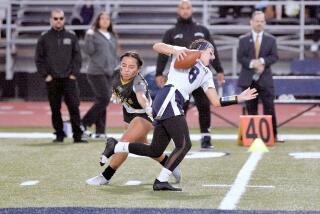When the country’s first transcontinental highway--Route 66--opened...
- Share via
When the country’s first transcontinental highway--Route 66--opened in 1926, it brought weary travelers in Model A’s and Studebakers across seven states and three time zones. Some were looking for a new life; others were in search of any life at all.
The latter were the ones in search of relief or a miracle cure that they hoped to find in the San Gabriel Valley town that would one day be dubbed “The City of Health.”
America’s highway sliced through the then smog-free, agricultural town of Duarte, bringing those afflicted with tuberculosis to two sanitariums, staffed with community volunteers. One of the facilities, founded in 1912, grew to become the world-renowned City of Hope National Medical Center for cancer research and treatment, while the other--founded in 1930--later was expanded into a full-service hospital known as Santa Teresita.
Duarte’s restorative powers also attracted the immortal “king of swing,” Glenn Miller. In 1940, Miller built a “stopover” house with a 12-car garage for his musicians in the city’s northeastern area. Townsfolk soon started humming as the familiar “Chattanooga Choo Choo,” “In the Mood” and “Little Brown Jug” wafted past their windows.
Miller died when his plane disappeared Dec. 16, 1944, over the English Channel. But his in-laws continued growing oranges for Sunkist on the 54-acre ranch, before it became part of a subdivision that includes Valley View Park.
In postwar years, Route 66 grew, was widened and smoothed into America’s Main Street, buzzing with returning GIs in search of jobs and housing. With scarce housing and plentiful orange and avocado groves, developers cut down the trees south of Huntington Drive and created what they called “GI houses.”
In 1957, the 6,000 residents of this bedroom community became concerned about encroaching gravel quarry operations, so they incorporated a 6.8-square-mile area and became the city of Duarte, named after Andres Duarte, a Mexican ex-corporal who owned the Azusa de Duarte rancho until he got behind on his tax payments.
In the late 1960s, the Foothill Freeway was built, dividing the city into northern and southern sections.
“Duarte’s Salute to Route 66,” a nostalgic journey celebrating the 70th anniversary of the storied roadway along Huntington Drive, will be held Sept. 21.
* Living Landmark: The state’s first recorded avocado tree flourishes at Mountain Avenue and Lewiston Street. This 103-year-old tree was given to grower William Chappelow by the Department of Agriculture in 1893.
* In a Class by Itself: The past comes alive as you consume linguine at Duarte’s 1909 five-room schoolhouse that was converted into the Old Spaghetti Factory restaurant at Central Avenue and Buena Vista Street.
* Highest Elevation: Duarte Mesa, perched on a hillside plateau at an elevation of 1,000 feet, is the city’s highest neighborhood and commands impressive views of the San Gabriel Valley. A wind-whipped fire roared through this exclusive neighborhood in 1980, destroying 35 homes in 30 minutes. Most victims chose to stay and rebuild.
* No Man’s Land: Plagued by gangs and crack dealers, about 11,000 frustrated residents of an unincorporated island wedged among the borders of Monrovia, Arcadia and Duarte (with a Duarte mailing address), formed a town council in 1993--known by its initials, MAD. These residents serve as a liaison between citizens and county agencies.
(BEGIN TEXT OF INFOBOX / INFOGRAPHIC)
By The Numbers
City Business
Incorporated: Aug. 22, 1957
Area in square miles: 7
Number of parks: 12
City employees: 38
1995-96 budget: $6 million
*
People
Population: 20,688
Households: 6,545
Average household size: 3
Median age: 33
*
Ethnic Breakdown
Asian: 11%
Black: 9%
Latino: 35%
White: 45%
Other: 1%
*
Money and Work Median household income: $37,695
Median household income / L.A. County: $34,965
Median home value: $171,300
Employed workers (16 and older): 10,208
Percentage of women employed: 56%
Percentage of men employed: 78%
Self-employed: 737
Car- poolers: 1,794
*
Retail Stores
Number of stores: 123
Number of employees: 1,373
Annual sales: $237 million
*
Families:
Married couples with children: 33%
Married couples with no children: 23%
Non-family households: 27%
Other types of families: 17%
Source: Claritas Inc. Household expenses are averages for 1994. All other figures are for 1990. Percentages have been rounded to the nearest whole number.
More to Read
Sign up for Essential California
The most important California stories and recommendations in your inbox every morning.
You may occasionally receive promotional content from the Los Angeles Times.












